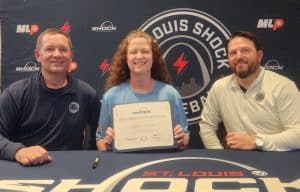Columbia upping in-person learning
The Columbia School Board voted 5-2 on Thursday to approve a plan to have the most students back in school since the pandemic began starting Feb. 16.
The plan, which board members Greg Meyer and Lisa Schumacher voted against, will have every student in fifth grade and below physically present from 8 a.m. to 3 p.m. Mondays through Thursdays.
Those children will attend from 8 a.m. to 12:30 p.m. Fridays.
For students in sixth grade and above, they will use a hybrid approach for attendance, with half of the student body learning in person during the morning and half learning in person during the afternoon.
“It’s the most like real school we can get it while keeping the meals safe, keeping the contact tracing reasonable,” Superintendent Chris Grode said of the plan. “Until we can get these masks off and go back to business as usual, I don’t know where else we can change it. This will be a huge expansion.”
Like now, pupils at the upper levels will be divided into two groups, with half of them physically attending from 8 a.m. to approximately 11 a.m. before returning home to continue classes in the afternoon.
When the A group leaves school, the B group will come for in-person learning in the afternoon after using remote learning that morning. The afternoon group will be present from about noon to 3 p.m.
The A group will go in the morning on Mondays and Tuesdays, while the B group will go in the morning on Wednesdays and Thursdays.
The two cohorts will alternate attending school in person from 8 a.m. to 12:30 p.m. on Fridays.
Both groups will be required to remotely attend classes during the times when they are not physically at their school.
Grode said parents have consistently told the district they want students at Columbia Middle School and Columbia High School to be in school every day and have morning and afternoon classes.
“There’s two ways to go about this. The first is to let everybody in, which, with the contact tracing and the health department, is not wise. The other way is this creative what where we have half our schedule in the morning,” Grode explained.
When students return from holiday break on Jan. 4, they will continue using the current approach that has all students in fifth grade and under attending in person every day from 8-12:30 and the older students using a hybrid model.
Grode said there were several reasons the district selected Feb. 16 as the start date for the new plan, with one of the chief being it needs time to hire new staff members and get them acclimated to the district.
“We are going to have to hire some remote teachers who will be certified staff members, who will be our staff members, who will be working with grade-level teams to ensure the instruction is right there with everybody else,” he noted.
Other reasons include that more people will have been vaccinated for COVID-19 by that point, flu season will be nearing its end, the weather will be warmer and allow for outdoor mask breaks and there will be two remote learning days and a holiday before starting the new system.
The district is also hoping the virus is less prevalent by mid-February after the holidays are over, as it anticipates as much as twice as many people will be forced to quarantine in sixth grade and above because they will be close contacts of people who test positive for coronavirus.
The plan Grode outlined also allows the district to avoid having lunch at the upper grade levels, which presents a host of safety problems amid the pandemic.
For younger students, the district is planning to hire lunch supervisors to ensure safety, but it has so far gotten zero applicants, per Assistant Superintendent Courtney Castelli.
Schumacher, Meyer and fellow board member Tammy Hines expressed various reservations with the plan, though Hines ultimately voted for it.
Schumacher said she thought families would find the shifting attendance times, particularly on Fridays, too confusing.
Grode said they are already keeping up with alternating schedules.
Schumacher had doubts children and teenagers alike will work remotely when they are not in school.
“Do you think that all of these kids are disciplined enough that they will sign on to be remote the rest of the day?” Schumacher asked.
Hines said she was especially concerned about that at the junior high level.
“They’re so much more immature at that age,” she said. “When you get to high school, there’s a little more level of maturity.”
Grode said he thinks the district’s pupils would meet the expectations and explained the new plan requires students to remotely attend classes, as opposed to completing schoolwork in an unscheduled format like they do now.
“I believe the kids will come back and do it and, if they don’t, we have truancy procedures we can go through,” he said.
Schumacher and Hines also expressed a desire to have CMS students in school more, like at the elementary level.
“To bring everybody in (grades) 6-8 at this time, I think, would be just dangerous, wrong, chaotic,” Grode countered. “It would be a lot of people quarantining.”
The problem with having the entire student body physically attend at the higher grade levels is they are “not compartmentalized” like their younger peers, which would create unsustainable levels of quarantining, Grode said.
Schumacher also said she was “totally against” the Feb. 16 start date, saying it was too late. She suggested this new plan begin Jan. 18, as that is also after a holiday.
Grode said that would not work.
“I can tell you right now, if we do it any earlier, the education is going to suffer,” he said. “It’s going to be pushed and rushed.”
Castelli added the district would have a “contract issue” if it did not get lunch supervisors for the elementary schools, as teachers have a lunch break guaranteed by their union.
“They need that break,” she said.
For his part, Meyer said he liked the direction the plan was moving, but he did not support Grode’s assessment that it might be what the district does for the remainder of the school year.
“I just wish we would keep pushing in the right direction, even if it is baby steps,” said Meyer, who has advocated for having all students in school as much as possible.
Board members Karen Anderson and Scott Middelkamp supported the plan.
“Our administrators have put a lot of time and research into this,” Anderson said. “It’s not just a feel-good plan. We’ve got to have some confidence in our administrators’ decisions. By going with this plan and getting it in place, it’s going to be much easier to transition to all-in as we go down the road.”
“I think taking these incremental steps is the way to go,” Middelkamp, the board’s president, agreed. “We keep working toward that end, and hopefully by the end of the year we’ll be all in.”






